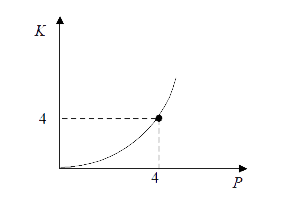What percentage of kinetic energy of a moving particle is transferred to a stationary particle, when moving particle strikes with a stationary particle of mass, 9 times in mass
To solve the problem of what percentage of kinetic energy is transferred from a moving particle to a stationary particle when they collide, we can follow these steps:
Step 1: Define the masses
Let the mass of the moving particle be m and the mass of the stationary particle be M=9m.
Step 2: Initial kinetic energy of the moving particle
The initial kinetic energy (KE) of the moving particle can be expressed as:
KEinitial=12mv2
where v is the initial velocity of the moving particle.
Step 3: Use conservation of momentum
In a perfectly elastic collision, momentum is conserved. The initial momentum of the system is:
pinitial=mv+0=mv
After the collision, let v1 be the velocity of the moving particle and v2 be the velocity of the stationary particle after the collision. The final momentum of the system is:
pfinal=mv1+9mv2
Setting the initial momentum equal to the final momentum gives us:
mv=mv1+9mv2
Dividing through by m simplifies to:
v=v1+9v2(1)
Step 4: Use conservation of kinetic energy
In a perfectly elastic collision, kinetic energy is also conserved. The initial kinetic energy is:
KEinitial=12mv2
The final kinetic energy after the collision is:
KEfinal=12mv21+12(9m)v22=12mv21+92mv22
Setting the initial kinetic energy equal to the final kinetic energy gives us:
12mv2=12mv21+92mv22
Dividing through by 12m simplifies to:
v2=v21+9v22(2)
Step 5: Solve the equations
From equation (1), we can express v1 in terms of v2:
v1=v−9v2
Substituting this into equation (2):
v2=(v−9v2)2+9v22
Expanding the squared term:
v2=v2−18vv2+81v22+9v22
This simplifies to:
v2=v2−18vv2+90v22
Cancelling v2 from both sides gives:
0=−18vv2+90v22
Factoring out v2:
v2(90v2−18v)=0
This gives v2=0 (not possible) or:
90v2=18v⟹v2=18v90=v5
Step 6: Find v1
Substituting v2 back into equation (1):
v1=v−9(v5)=v−9v5=v(1−95)=v(−45)=−4v5
(Note: The negative sign indicates the direction of motion is reversed.)
Step 7: Calculate the final kinetic energies
Now we can calculate the final kinetic energies:
- For the moving particle:
KE1=12m(−4v5)2=12m⋅16v225=8mv225
- For the stationary particle:
KE2=12(9m)(v5)2=12(9m)⋅v225=9mv250
Step 8: Calculate the percentage of kinetic energy transferred
The percentage of kinetic energy transferred to the stationary particle is given by:
Percentage=(KE2KEinitial)×100=⎛⎜⎝9mv25012mv2⎞⎟⎠×100
This simplifies to:
=(9mv2/50mv2/2)×100=(950⋅21)×100=(1850)×100=36%
Final Answer
Thus, the percentage of kinetic energy transferred to the stationary particle is 36%.
---
Let the mass of the moving particle be m and the mass of the stationary particle be M=9m.
The initial kinetic energy (KE) of the moving particle can be expressed as:
KEinitial=12mv2
where v is the initial velocity of the moving particle.
In a perfectly elastic collision, momentum is conserved. The initial momentum of the system is:
pinitial=mv+0=mv
After the collision, let v1 be the velocity of the moving particle and v2 be the velocity of the stationary particle after the collision. The final momentum of the system is:
pfinal=mv1+9mv2
Setting the initial momentum equal to the final momentum gives us:
mv=mv1+9mv2
Dividing through by m simplifies to:
v=v1+9v2(1)
In a perfectly elastic collision, kinetic energy is also conserved. The initial kinetic energy is:
KEinitial=12mv2
The final kinetic energy after the collision is:
KEfinal=12mv21+12(9m)v22=12mv21+92mv22
Setting the initial kinetic energy equal to the final kinetic energy gives us:
12mv2=12mv21+92mv22
Dividing through by 12m simplifies to:
v2=v21+9v22(2)
From equation (1), we can express v1 in terms of v2:
v1=v−9v2
Substituting this into equation (2):
v2=(v−9v2)2+9v22
Expanding the squared term:
v2=v2−18vv2+81v22+9v22
This simplifies to:
v2=v2−18vv2+90v22
Cancelling v2 from both sides gives:
0=−18vv2+90v22
Factoring out v2:
v2(90v2−18v)=0
This gives v2=0 (not possible) or:
90v2=18v⟹v2=18v90=v5
Substituting v2 back into equation (1):
v1=v−9(v5)=v−9v5=v(1−95)=v(−45)=−4v5
(Note: The negative sign indicates the direction of motion is reversed.)
Now we can calculate the final kinetic energies:
- For the moving particle:
KE1=12m(−4v5)2=12m⋅16v225=8mv225
- For the stationary particle:
KE2=12(9m)(v5)2=12(9m)⋅v225=9mv250
The percentage of kinetic energy transferred to the stationary particle is given by:
Percentage=(KE2KEinitial)×100=⎛⎜⎝9mv25012mv2⎞⎟⎠×100
This simplifies to:
=(9mv2/50mv2/2)×100=(950⋅21)×100=(1850)×100=36%
Thus, the percentage of kinetic energy transferred to the stationary particle is 36%.
Topper's Solved these Questions
Similar Questions
What percentage of K.E. of a moving particle is transferred to a stationary particle, when moving particle strikes with a stationary particle of mass (a) 19 times in mass (b) equal in mass (c) 119 th of its mass ?
View SolutionWhat percentage of K.E. of a moving particle is transferred to a stationary particle when it stikes the stationary particle of 4 times its mass?
View Solution
Knowledge Check
In a stationary wave all particles are –
AAt rest at the same time twice in every period of oscillationBAt rest at the same time once in every period of oscillationCNever at rest at the same timeDAt rest alwaysThe energy of a particle moving at 5m/s ie 125 J. The mass of particle is
A4 kgB6 kgC10 kgD25 kgThe energy of a particle moving at 5m/s ie 125 J. The mass of particle is
A4 kgB6 kgC10 kgD25 kg
What percentage of the K.E. of a moving particle is transferred to a stationary particle when it strikes the stationary particle four times its mass ?
View SolutionWhat percentage of K.E. of a moving particle is transferred to stationary sphere particle , when it strikes the stationary particle of (a) 100 times its mass (b) equal mass ?
View SolutionA moving particle collides with a stationary particle and imparts kinectic energy to the stationary particle . What percentage of kinectic energy will be transferred to the stationary particle if the mass of stationary particle is 30 times the mass of moving particle ?
View SolutionA graph between kinetic energy and momentum of a particle is plotted as shown in the figure. The mass of the moving particle is :

View SolutionIn a stationary wave all the particles
View Solution
